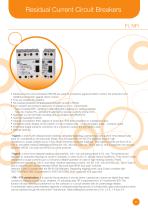 Website:
Iskra d.d.
Website:
Iskra d.d.
Group: Iskra
Catalog excerpts

Residual Current Circuit Breakers FI, NFI • Residual current circuit breakers (RCCB) are used for protection against indirect contact, fire protection and additional protection against direct contact. • They are suitable for isolation. • No overload protection or short-circuit protection is built in RCCB. • Two versions according to behaviour in presence of d.c. components: - Type A (marked NFI) - sensitive to alternating and pulsating d.c. residual currents. - Type AC (marked FI) - sensitive to alternating residual currents of sine form. • Assembly to a 35 mm wide mounting rail in accordance with EN 60715. • Optional operation position. • Degree of protection IP20, degree of protection IP40 after installation in a distribution box. • Additional colour display of the position of main contacts (red - contacts closed, green - contacts open). • A terminal shape prevents connection of a conductor outside the connection area. • Special versions: - Type S: a switch with delayed break enabling selectivity regarding a general type and a short-time delayed type (type G) connected on the load side. Break time is longer than 40 ms. The switches excel in high resistance to surge currents (up to 3 kA), which prevents unwanted trippings. Their rated currents are from 25 to 100 A, and rated residual operating currents are 100, 300 and 500 mA. This is type A, and a customer can choose between NFI2S two-pole and NFI4S four-pole switches. - Type G: a short-time delayed breaking characteristic (min. non-actuating period is 10 ms). The switches are resistant to unwanted trippings at current impulses or when built-in in special critical conditions. They excel in high resistance to surge currents (up to 3 kA) and a reliable operation in case of high making currents. Rated currents are from 25 to 100 A, and rated residual operating currents are 30, 100, 300 and 500 mA. This is type A, and a customer can choose between NFI2K two-pole and NFI4K four-pole switches. Versions S and G comply with the EN 61008 standard. Regarding tripping times, type G also complies with ÖVE/ ÖNORM E 8601 (supplement to ÖVE EN 61008). Both types are VDE approved. - FIR – FIT combination: It is used for the protection in circuits where operational currents are higher that rated currents of residual current circuit breakers. An actuating relay FIR is separated from a FI transformer (FIT).The function of load switching is performed by the contactor or a circuit-breaker with an undervoltage release. A combination rated current therefore depends on selected switching devices. It is limited with cable cross-sections which can be inserted through the hole of the FI transformer. Rated differential currents are 0.3 A, 0.5
Open the catalog to page 1
Residual Current Circuit Breakers FI, NFI TECHNICAL DATA Type AC Rated voltage Rated impulse voltage Rated frequency Rated current Rated residual operating current Rated making and breaking capacity = Rated residual making and breaking capacity Max. back-up fuse for short-circuit current 100 (In = 100 A) Rated conditional short-circuit current Terminal capacity Ambiemt temperature Storage temperature Tightening torque Max. tripping times, types AC, A Response time delay, types A-G, A-S A sealing cover for two-pole (SCNFI2) and four-pole (SCNFI4) switches DIMENSIONS / ,03 0 / 0,3 Rated...
Open the catalog to page 2All Iskra d.d. catalogs and technical brochures
-
POWER ELECTRONIC CAPACITORS
51 Pages
-
Strip Wound Cores
20 Pages
-
Professional Batteries
4 Pages
-
General Sales Conditions
4 Pages
-
SparkWave SDR GE
2 Pages
-
SparkWave High Speed PDH
2 Pages
-
SparkWave SDR ADM
2 Pages
-
SparkWave SDR STM
2 Pages
-
SparkWave SDR GE2
2 Pages
-
SparkLight ADM 16
2 Pages
-
SparkLight ADM 1,4
2 Pages
-
SparkLight HSP
2 Pages
-
DZ9 Catalogue
2 Pages
-
eMis
27 Pages
-
Bistable switch
26 Pages
-
Low voltage switchgear
138 Pages
-
ECU
2 Pages
-
NEO 3000
37 Pages
-
FPC 200
4 Pages
-
Radio Interfence
72 Pages
-
potentiometers
4 Pages
-
Switch disconectors
7 Pages
-
NFIF
4 Pages
-
NFIB
4 Pages
-
Bistable Switches
24 Pages
-
DC-link and Snubber Capacitors
42 Pages
-
Power Factor Correction Banks
30 Pages
-
Power Electronics Capacitors
5 Pages
-
Dry Capacitors
4 Pages
-
CAU380 Bay Computer
8 Pages
-
MCE940 SCADA
4 Pages
-
NEO3000 Substation System
8 Pages
-
Energy Sector
52 Pages
-
Product line
20 Pages
-
Energy meters
44 Pages
-
Low voltage pfc
30 Pages
-
DC link capacitors and snubbers
16 Pages
-
Electrical measuring instruments
110 Pages
Archived catalogs
-
POWER ELECTRONIC CAPACITORS
49 Pages
-
Moulded case circuit breakers
24 Pages
-
Overvoltage protection
72 Pages
-
DC link capacitors
2 Pages
-
Capacitors Selection Guide
2 Pages
-
Capacitors for electronics
44 Pages
-
Lighting capacitors
28 Pages
-
Motor capacitors
28 Pages
-
Capacitor banks - short form
4 Pages
-
Capacitor banks
32 Pages
-
Induction heating capacitors
24 Pages
-
High-voltage power capacitors
24 Pages





































































